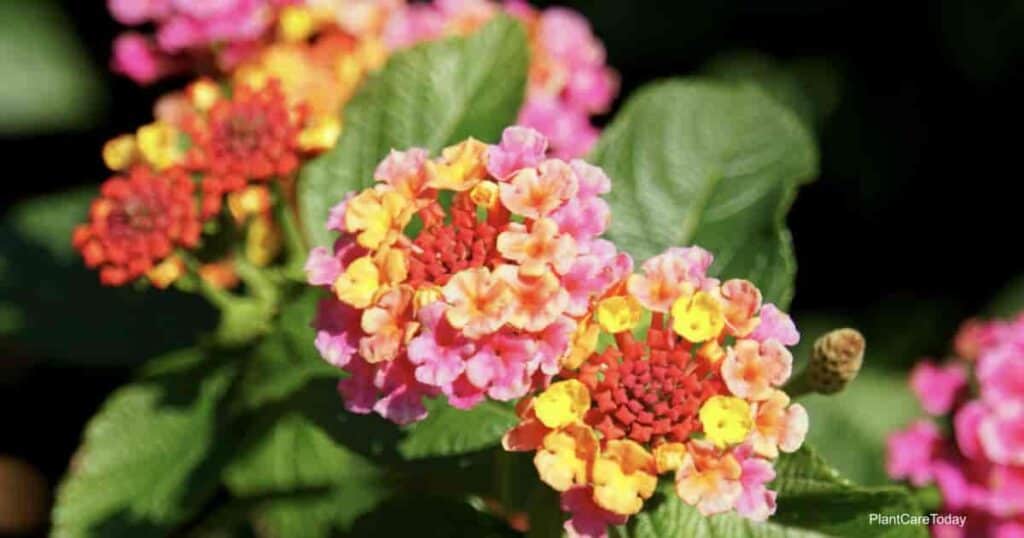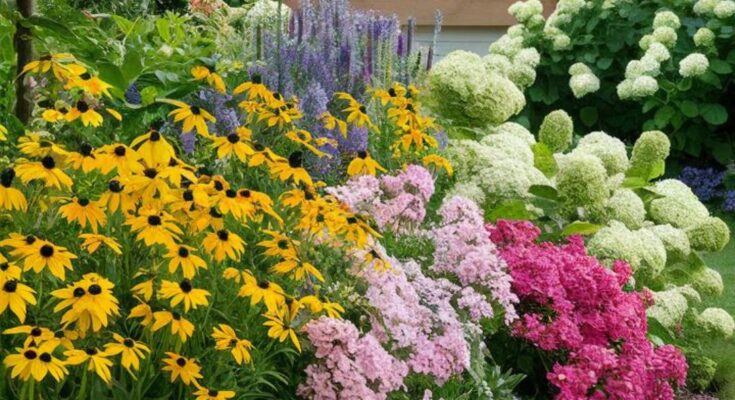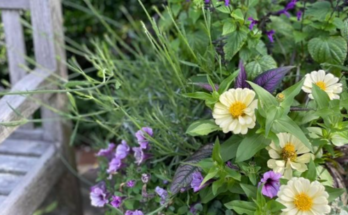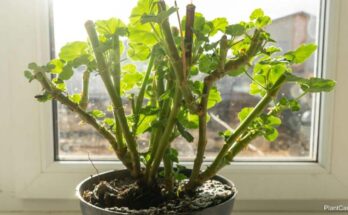Creating an edge to separate your garden from your lawn is a great way to design your outdoor space. Growing beautiful plants you like is one of the easiest ways to make your garden look amazing.

These plants add aesthetic appeal and serve practical purposes such as defining spaces and preventing soil erosion. Like a well-decorated house with nice rugs and carpets, your garden looks better with these edging plants.
Wondering about the the best plants for creating a bright and beautiful edge in the garden? This article features 15 of the top choices that thrive in various conditions and climates.
Whether they are sun-loving varieties or those that flourish in shady spots, these plants will add to the overall look of any garden landscape.
#1 – Coleus
Coleus is an excellent choice for adding vibrant color to garden edges.


Known for its variegated foliage, coleus comes in a stunning array of colors and patterns.
The plant grows 10-15 inches tall and is annual, making it perfect for a season annual. Coleus can also be trained into a small tree.
These plants thrive in full sun and shade. Their colorful leaves range from red to pink, green, purple, yellow, or multicolored, making them a versatile option for various garden styles and themes.
#2 – Sweet Alyssum
Sweet Alyssum is a favorite for edging gardens and walkways.


This low-growing plant features tiny flowers in white, pink, or purple. It creates a soft, carpet-like effect. The blooms have a sweet fragrance that attracts bees and butterflies. Sweet Alyssum thrives in cool weather and well-drained soil. It’s easy to grow and requires minimal care.
#3 – Hosta
Hostas are a popular choice for colorful edging.


They are known for their large, lush leaves in various shades of green, blue, and even variegated patterns. These shade-loving perennials thrive in zones 3-9. They are low-maintenance and can adapt to different soil conditions.
Hostas grow well in shady areas, making them perfect for edging pathways and borders where the sun doesn’t reach. Their robust foliage creates a neat and attractive border.
#4 – Coral Bells
Coral Bells, also known as Heuchera, are popular for their vibrant, saturated foliage. They display feathery spikes of tiny flowers in various colors.


These plants thrive in rich, well-draining soil and prefer full to partial sun.
Coral Bells are great for filtered sun spots and add a pop of color to garden borders.
They are also drought-tolerant and attract pollinators like butterflies and hummingbirds. Coral Bells are an excellent choice for colorful, low-maintenance edging.
#5 – Lamb’s Ear
Lamb’s Ear forms a dense carpet of silvery-green foliage.


It is known for its soft, velvety leaves that resemble a lamb’s ear. This plant grows well in full sun or partial shade.
In midsummer, it produces upright spikes of lilac-plum flowers. Lamb’s Ear prefers well-drained soil and can thrive in moist and dry conditions. It is often used as a ground cover or in container plantings.
#6 – Creeping Jenny
Creeping Jenny is an excellent choice for colorful garden edging.


Its bright yellow-green leaves add a pop of color to any garden.
This plant spreads quickly and can cover ground effectively. It’s a great option to soften hard edges and define garden spaces.
Creeping Jenny is easy to grow and requires minimal maintenance, making it a favorite for gardeners.
#7 – Sedum
Sedum, also known as stonecrop, is a versatile plant ideal for garden edging.


It thrives in well-drained soil and can handle full sun to part shade.
There are various sedum varieties, each offering unique colors and textures. Some have silvery foliage, while others display vibrant green or blue-green leaves.
Sedum is hardy in Zones 3 to 9, making it suitable for many climates.
This plant is also drought-tolerant, making it low-maintenance and perfect for busy gardeners.
Its small size and spreading habit make it an excellent choice for creating colorful, attractive borders.
#8 – Dusty Miller
Dusty Miller is a popular choice for garden edges. It features silvery-white leaves that add striking contrast to any garden.


This plant prefers full sunlight and thrives in well-drained soil with a pH of 5.5 to 6.0.
Dusty Miller grows to a height of six to 18 inches. In summer, it produces small yellow flowers.
The plant is hardy and can be propagated from stem cuttings. Place the cuttings in a moistened potting mix in a bright, warm location.
Dusty Miller is drought-tolerant and pairs well with many other edging plants. It’s a low-maintenance option for adding color to garden borders.
#9 – Pansy
Pansies are a vibrant choice for colorful edging. They come in a variety of shades, including yellow, purple, blue, and orange. Their blooms are typically about three inches wide.


These plants thrive in well-drained soil. They can grow in partial shade but perform best in the morning sun.
Regular fertilization helps keep their blooms healthy and prolific.
For compact growth, pansies usually reach a height of six to eight inches. They are suitable for small spaces and container gardens, making them a versatile addition to any garden.
Regular trimming encourages new growth and maintains their shape.
#10 – Hakone Grass
Hakone Grass, also known as Hakonechloa, is a graceful plant that adds a touch of elegance to any garden edge.
It is prized for its arching, bamboo-like leaves that bring texture and movement.
This grass thrives in shady areas and prefers well-drained, moist soil. Its bright green or variegated leaves can lighten up dark corners.
Hakone Grass pairs well with many plants, including ferns and hostas.
It grows slowly and needs minimal maintenance, making it an excellent choice for gardeners of all experience levels.
#11 – Ajuga
Ajuga, also known as bugleweed, is a great choice for colorful edging.


It forms a dense mat of foliage, making it perfect for covering ground in garden borders.
This plant has leaves in shades of green, purple, bronze, or black and blooms with blue to purple flowers.
Ajuga is hardy and resistant, thriving in USDA zones 3-10. It grows best in partial to full shade.
#12 – Dianthus
Dianthus, often called “pinks,” features bright flowers perfect for edging garden borders and pathways.


These plants have silvery blue-green foliage that forms a low mound. They are hardy and can thrive in full sun to light shade.
Dianthus flowers also have a pleasant, clove-like fragrance that attracts butterflies and pollinators.
#13 – Periwinkle
Periwinkle is a versatile edging plant with attractive, glossy green leaves and delicate, star-shaped flowers.


It thrives in partial to full shade, making it an excellent choice for borders in less sunny areas.
This plant is also known for its ability to spread quickly, providing good ground cover and helping to prevent soil erosion.
Its flowers come in shades of blue, purple, and white, adding a splash of color to any garden.
#14 – Petunia
Petunias are popular edging plants for their colorful blooms and ease of care.


They come in a variety of vibrant hues, including pink, purple, white, and red.
These plants thrive in full sunlight and well-drained soil.
Petunias are perfect for adding a pop of color along garden borders or pathways. Regular watering helps them flourish, making them a bright addition to any garden.
#15 – Liriope
Liriope, also known as lilyturf, is a hardy plant perfect for garden edging.


It features narrow, grass-like leaves and spikes of purple or white flowers.
These plants are low maintenance and can thrive in various conditions.
They grow well in both sun and shade and are drought-tolerant once established.
Liriope spreads slowly, forming dense clumps that help define garden borders.
#16 – Lantana
Lantana is a versatile choice for colorful edging. It thrives in full sunlight and does well in well-draining soil.


This plant is heat tolerant and deer resistant, making it low-maintenance.
Gardeners will appreciate its vibrant blooms in shades of red, yellow, and orange.
Lantana can grow 3-4 feet tall and 1-3 feet wide, providing ample edge coverage.
Benefits of Colorful Edging
Colorful edging plants can greatly enhance the look of any garden. They also improve curb appeal, create visual interest, and efficiently define garden borders.
These plants serve aesthetic and practical purposes, making them essential to garden design.
Enhanced Curb Appeal
Colorful edging plants can grab attention and improve the appearance of a garden. Bright tulips and euonymus, in particular, can have a significant impact.
They are often the first thing people notice and can greatly enhance a property’s overall appeal.
Using vibrant plants to line pathways and the front of flower beds can create a warm, inviting atmosphere. The pop of color can also give a home a well-tended and inviting look.
Plants like hydrangeas, marigolds, and lavender add color and bring in lovely scents. These plants can potentially transform any ordinary garden into a little paradise.
Creating Visual Interest
Edging plants make gardens more visually appealing and create a smooth transition between different garden areas.
Flowering plants like forget-me-nots and daisies can add layers of color, while using plants with various leaf shapes and sizes can bring texture to the garden, making it more interesting to look at.
Plants that bloom at different times of the year can keep the garden visually appealing year-round, always offering something new to catch the eye.
Defining Garden Borders
Border plants clearly define the edges of garden spaces, which are both practical for maintenance and visually appealing.
Low-growing plants like hostas and creeping thyme, which grow close to the ground, can form a natural border without obstructing the view. They can also help in separating different types of plants within the garden.
These borders can guide foot traffic and keep other plants from spreading into unwanted areas. This makes the garden easier to manage and more orderly.
Tips for Choosing Colorful Edging Plants
When choosing colorful edging plants, you should split the text into at least two sentences per paragraph. This will make it easier to read and understand.
Consider Sunlight Requirements
Different plants have varying sunlight needs.
For example, thrift thrives in full sun and is drought-tolerant, making it suitable for sunny spots. On the other hand, epimedium prefers shady areas and blooms in spring.


Make sure to check the plant’s sunlight requirements to ensure it gets the appropriate amount of light. A mix of sun-loving and shade-tolerant plants can add variety to your garden.
Use labels to mark the sunlight needs of each plant and arrange your garden accordingly.
Selecting Based on Soil Type
Soil type also plays a crucial role in plant health. For example, Catmint grows best in well-draining soil, while euonymus can adapt to various soil types.


You may want to test your soil or seek advice from a local garden center to learn about the pH level and type of soil in your garden. Most plants do best in nutrient-rich, well-draining soil, but some may have more specific requirements.
Improve soil quality by adding compost or mulch, enhancing drainage, and providing nutrients.
Maintenance and Growth Patterns
Maintenance is another key factor to consider when choosing edging plants. Coleus needs regular watering to keep its soil moist and should be placed in partial sun.


This plant also benefits from pinching back to encourage bushy growth. In contrast, thrift is low-maintenance, requiring little more than occasional watering.
Understanding the growth patterns of selected plants can help keep your garden neat and attractive. Some plants may need regular pruning to maintain their size and shape.
Think about how much time you can dedicate to garden care and choose plants accordingly. This ensures your garden stays vibrant with minimal effort.
Design Ideas for Colorful Garden Edging
Adding colorful edging to your garden can enhance visual appeal and provide practical benefits. This section explores creating distinct borders, varying colors throughout the seasons, and mixing different textures and heights in your garden.
Creating Contrasting Borders
Using contrasting colors for your garden borders can make your plants stand out.
Consider planting catmint with its purple-and-blue blooms next to yellow flowers like daffodils. The stark difference in color catches the eye and defines the garden space.
Colorful tulips and forget-me-nots also create vibrant edges. Bright combinations, such as pink and blue, can create a lively and inviting atmosphere in your garden.


Don’t forget about green foliage plants like euonymus, which can provide a continual contrast with their bold leaves.
When planning your border, think about the color wheel. Colors opposite each other on the wheel, like purple and yellow or red and green, create striking contrasts. This can make your garden look more dynamic.
Seasonal Color Changes
Plan for seasonal changes to keep your garden colorful year-round.
For spring color, plant perennials like epimedium offer pink, purple, and yellow flowers. This plant blooms early in the season and has attractive foliage that changes color in autumn.
Catmint is another excellent choice. After its first bloom, cutting it back can encourage more blooms, giving you multiple flushes of color throughout the growing season.
Perennials that rebloom can keep your garden looking fresh from spring to fall. In summer, consider edging with sun-loving plants such as daisies or daylilies.
For autumn, foliage plants like euonymus offer colorful leaves that add warmth.
Combining Textures and Heights
Integrating different textures and heights can add depth and interest.
Tall, spiky plants like irises pair well with soft, mounding plants like catmint. This contrast in form makes each plant stand out more.


A mix of groundcovers with taller plants, such as creeping thyme, ensures that your edges remain lush and full.
Perennials like barrenwort add delicate flowers in spring, with foliage that adds texture throughout the year.
Create layers by placing taller plants at the back and shorter ones at the front. This helps in showcasing each plant’s unique features.
Using a variety of plants not only adds visual interest but also supports a healthy garden ecosystem.
Source link




